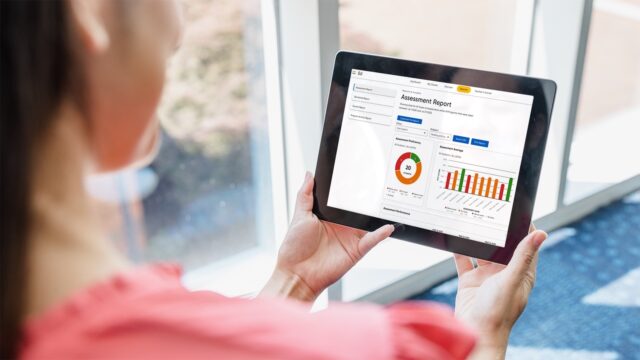
Data-driven instruction, when effectively implemented, can dramatically improve student outcomes and serve as a foundational framework for teaching and learning. By analyzing data about student performance, educators can tailor their teaching to meet the specific needs of students and provide a common language for school leaders and educators to communicate learning goals in an objective way.
Research has shown that data-driven instruction can have a positive impact on teachers’ instructional strategies and students’ academic performance. In this article, we will define what data-driven instruction entails and explore some of its potential benefits and challenges.
Data-Driven Instruction: Definition and Process
What is data-driven instruction (also referred to as data-informed instruction or data-based instruction)? In short, data-driven instruction is a method of making instructional decisions based on analyzing data. In many ways, teachers already implicitly use data to inform their instruction—for example, when a teacher reviews students’ test scores and decides to reteach a concept, they are using data to inform their instructional decisions. When teachers explicitly adopt a data-driven approach to their instruction, they are able to plan, predict, and respond to student needs even more effectively.
Data-driven instruction is a cyclical process that involves three key phases.
- The first phase is the intentional assessment of student learning; in this phase, assessments gather specific information about learners and align with learning objectives.
- The second phase is data analysis and interpretation, where educators use tools and techniques to analyze assessment data to identify patterns in student performance.
- The third phase involves implementing targeted, strategic instructional changes to address specific areas of need based on the insights gained from data analysis.
Throughout all three phases, continuous monitoring and adjustment of instruction are necessary to ensure that students are making progress toward their learning goals.

Ongoing and Purposeful Data-Driven Assessment
Knowing what learners know and can do is a critical part of teaching and learning, and for data-driven instruction to be effective, assessment must be purposeful, that is, well-suited for what the assessment is intended to assess. In data-driven instruction, ongoing assessment is an essential component, where data are collected at regular intervals and provide critical information to educators. Additionally, continuous assessment allows for monitoring of student progress and adjustment of instruction as needed.
Assessments should gather specific information about learners, and educators can use those assessment results to inform and adjust their instruction. Rather than simply administering tests or quizzes to collect data, assessments in a data-driven approach are chosen to align with learning objectives and designed to provide data that can be used to improve instruction. The goal is to use the information gained from assessment data to improve learner outcomes.
How Does Data Drive Instruction?
There is no question that an effective educator must rely, at least in part, on intuition and relationships. After all, education is much an art as it is a science. However, educators can also use assessments—especially ones designed to gather data about student proficiency against grade-level expectations—to inform instructional decisions.
Educators in Alabama’s Mobile County Public School System, for example, administered interim assessments three times across a school year in order to gauge their students’ grade-level understanding of math. Each assessment took up a 45-minute class period, and the results were then able to inform instruction and drive student growth. HMH’s learning platform Ed displayed the assessment data as reports on students’ domain performance and standards proficiency.
Using the reports, teachers and administrators were then able to determine which students should receive Tier 2 or Tier 3 intervention in math and precisely which topics they needed support in. Mobile County expanded the number of classrooms using Math 180, a program designed to deliver effective Tier 3 math intervention, and trained additional educators on using it. This strategy was implemented to support students who needed more help developing foundational skills and to tackle challenges brought on by disrupted learning.
How Is Data-Driven Instruction Different from Other Instructional Approaches?
As discussed, data-driven instruction emphasizes using data to identify specific areas where students need support and then adjusting instruction to address those needs. This approach to instruction is similar to other instructional approaches that involve making changes to meet the needs of individual learners, such as differentiated instruction. However, true to its name, data-driven instruction is focused on using insights from data to identify specific areas of weakness or strength to make targeted adjustments to instruction and improve learner outcomes. Data-driven instruction, though, isn’t a standalone instructional strategy meant to replace other strategies, but rather it’s a general practice that is intended to work alongside other instructional approaches and priorities.
It is also important to note that data-driven instruction can have the largest impact when adopted as a larger, school- or district-based effort to instill a culture of data. This is often accompanied with the implementation of professional learning communities, or PLCs, that empower teachers and school leaders to collaboratively make sense of student data.
What Are the Benefits of Data-Driven Instruction?
By using data to inform instruction, teachers can tailor their instruction to meet the needs of students, resulting in improved student learning outcomes. Some additional benefits of data-driven instruction include:
- Increased teacher effectiveness: Data-driven instruction can provide teachers with timely and relevant information about student performance, allowing them to make more informed decisions in their lesson planning.
- Enhanced student engagement: Students may be more motivated and engaged in learning if they see their progress on skills and standards rather than just assignments and grades. Data can also provide manageable and clearly-articulated goals for students to strive for.
- Greater collaboration: Data-driven instruction can encourage collaboration among teachers and administrators as they work together to understand and interpret data.
- Improved communication with family: By using data to inform instruction, teachers can provide family members with a clearer picture of their learners’ progress.
- Shift from a “testing” perspective to an “assessment” perspective: Teachers can shift to viewing assessments as opportunities to collect data about the path ahead on a learning journey rather than viewing tests as the final result of learning.
What Are the Challenges Implementing Data-Driven Instruction?
While data-driven instruction can benefit teachers and learners significantly, it is not without its challenges. One of the primary challenges is that implementing data-driven instruction requires a cultural shift in schools. Instead of merely covering content, data-driven instruction promotes mastery of specific skills and concepts. For example, the data may suggest reteaching a specific skill or concept, but the demands of the curriculum may pressure a teacher to move on instead of reteaching. This shift can be particularly challenging in districts that are already comfortable with traditional approaches to instruction and assessment.
Importantly, implementing data-driven instructional methods is a challenging process that is best implemented with ongoing collaboration and professional development. Districts that implement collaborative models of professional development, such as PLCs, can effectively support the cultural shift toward data-driven instruction by allowing groups of teachers to invest time to analyze and understand learner data, as well as nurture teachers’ growth mindset around adopting new tools and technologies.
Ultimately, there’s no single way to implement data-driven instruction. Each school has its own context to consider, such as teachers’ backgrounds, students’ needs, and the available tools and resources. Therefore, schools must experiment to determine what works for them.
Conclusion
When implemented well, data-driven instruction can be a formidable instructional approach to help teachers make informed decisions about instruction to support student learning. Through ongoing and purposeful assessment and careful analysis and interpretation of data, educators can be empowered to plan instruction in advance, meet learners where they are in real time, and accelerate achievement in their classrooms.
***
For more on data-driven assessments and instruction, explore HMH assessments that help educators gain a complete picture of student achievement. Additionally, watch our customer success stories for more examples of data-driven instruction effectively implemented in schools, plus other ways educators improved student outcomes by partnering with HMH.
Build a data-driven culture in your school or district.















